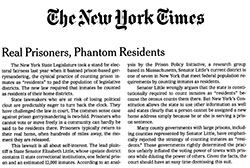New Data Will Boost State and Local Efforts to Draw Fairer Districts
April 20, 2011
FOR IMMEDIATE RELEASE April 20, 2011
CONTACT:
Tim Rusch, trusch@demos.org, (212) 389-1307
Peter Wagner, pwagner@prisonpolicy.org, (413) 527-0845
Aleks Kajstura, akajstura@prisonpolicy.org, (413) 527-0845
Anna Pycior, apycior@demos.org, (212) 389-1408
Advocates Hail Census Bureau’s Release of Data to Assist in Correcting Prison-Based Gerrymandering;
New Data Will Boost State and Local Efforts to Draw Fairer Districts
New York, NY—Today, the Census Bureau released a new data product that will assist state and local governments in avoiding prison-based gerrymandering, a practice which unjustly gives districts that contain prisons extra representation in the legislature. The Bureau’s accelerated release of 2010 group quarters table was hailed by Demos and the Prison Policy Initiative, two national non-partisan organizations working on state and local redistricting reform.
Under most state constitutions and election law statutes, a prison cell is not a residence, but existing Census Bureau practices count incarcerated people as residents of the prison location.
As a result of discussions last year between Census Director Robert Groves and Rep. Wm. Lacy Clay, Jr., Chairman of the House Subcommittee on Information Policy, Census and National Archives, the Census Bureau has now for the first time identified which census blocks contain group quarters, such as correctional facilities, early enough that state and local redistricting bodies can choose to use this data to draw fair districts.
In the past, states and counties that wished to correct this overrepresentation of districts with prisons had received little support from the Census Bureau, as the Bureau traditionally published the prison populations at the census block level long after redistricting is underway or completed.
“The Census Bureau has taken an important step toward recognizing the need for improved data on incarcerated populations so that states can end the practice of prison-based gerrymandering,” said Peter Wagner, Executive Director of the Prison Policy Initiative. “States and local governments that have been struggling to correct distorted redistricting figures are eagerly looking forward to this data.”
Advocates had earlier urged the Census to determine the home addresses of incarcerated people and count them there, but it was too late in the 2010 Census planning to change that. This interim solution of releasing accelerated data identifying prison populations will assist governments that wish to make their own adjustments for state and local redistricting. Legislation to make such adjustments was enacted last year in Maryland, New York and Delaware, and is currently under consideration in several states including in Illinois, Rhode Island and Oregon.
In past years, state legislative districts in many states have had prison populations large enough to run afoul of constitutional “one person, one vote” standards. Local county and municipal districts have seen even greater distortions, with many districts having more incarcerated people than voters. These states and localities can now more readily identify the prison populations before drawing district lines, and make appropriate adjustments to avoid distortions in representation.
“For too long, communities with large prisons have received greater representation in government on the backs of people who have no voting rights in the prison community and are not considered legal residents of the prison district for any other purpose. The Census Bureau’s new data will greatly assist states and localities in correcting this injustice and drawing fair and accurate districts that honor the principle of one person, one vote,” said Brenda Wright, Director of the Democracy Program at Demos.
While hailing the Census Bureau’s first step toward improving its practices on counting incarcerated persons, advocates are engaged in a longer-term campaign to encourage the Bureau to implement a more permanent solution under which the decennial census would count incarcerated persons at their home locations.
The new data has been published on the Census Bureau’s Redistricting Data Office website at http://www.census.gov/rdo. To make this data easier to use by redistricting professionals and democracy advocates, the Prison Policy Initiative will be producing shapefiles later today with the group quarters data and making a web-based database of annotations available to the public at http://www.prisonersofthecensus.org/data/. In addition, Demos and PPI have a publication, Preventing Prison-Based Gerrymandering in Redistricting: What to Watch For, which provides guidance on how advocates and map-drawers can minimize the impact of prison-based gerrymandering when redrawing state and local district lines.
###




